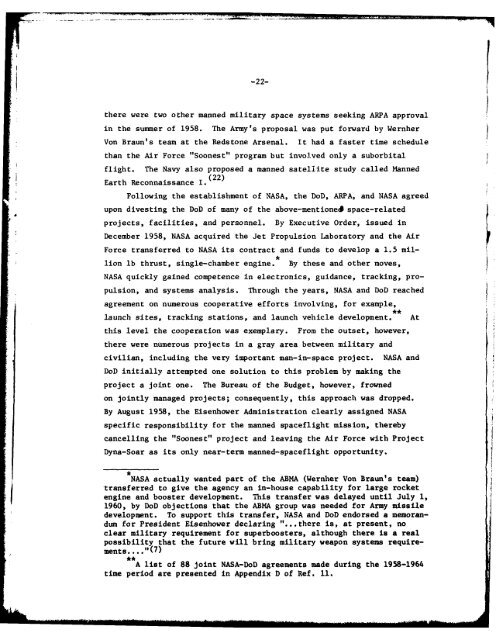A Case Study in NASA-DoD - The Black Vault
A Case Study in NASA-DoD - The Black Vault
A Case Study in NASA-DoD - The Black Vault
Create successful ePaper yourself
Turn your PDF publications into a flip-book with our unique Google optimized e-Paper software.
-22-<br />
there were two other manned military space systems seek<strong>in</strong>g ARPA approval<br />
<strong>in</strong> the summer of 1958.<br />
Von Braun's team at the Redstone Arsenal.<br />
<strong>The</strong> Army's proposal was put forward by Wernher<br />
It had a faster time schedule<br />
than the Air Force "Soonest" program but <strong>in</strong>volved only a suborbital<br />
flight. <strong>The</strong> Navy also proposed a manned satellite study called Manned<br />
(22)<br />
Earth Reconnaissance I.<br />
Follow<strong>in</strong>g the establishment of <strong>NASA</strong>, the <strong>DoD</strong>, ARPA, and <strong>NASA</strong> agreed<br />
upon divest<strong>in</strong>g the <strong>DoD</strong> of many of the above-mentioned space-related<br />
projects, facilities, and personnel. By Executive Order, issued <strong>in</strong><br />
December 1958, <strong>NASA</strong> acquired the Jet Propulsion Laboratory and the Air<br />
Force transferred to <strong>NASA</strong> its contract and funds to develop a 1.5 million<br />
lb thrust, s<strong>in</strong>gle-chamber eng<strong>in</strong>e.<br />
By these and other moves,<br />
<strong>NASA</strong> quickly ga<strong>in</strong>ed competence <strong>in</strong> electronics, guidance, track<strong>in</strong>g, propulsion,<br />
and systems analysis.<br />
Through the years, <strong>NASA</strong> and <strong>DoD</strong> reached<br />
agreement on numerous cooperative efforts <strong>in</strong>volv<strong>in</strong>g, for example,<br />
launch sites, track<strong>in</strong>g stations, and launch vehicle development.<br />
this level the cooperation was exemplary. From the outset, however,<br />
there were numerous projects <strong>in</strong> a gray area between military and<br />
civilian, <strong>in</strong>clud<strong>in</strong>g the very important man-<strong>in</strong>-space project. <strong>NASA</strong> and<br />
<strong>DoD</strong> <strong>in</strong>itially attempted one solution to this problem by mak<strong>in</strong>g the<br />
project a jo<strong>in</strong>t one.<br />
<strong>The</strong> Bureau of the Budget, however, frowned<br />
on jo<strong>in</strong>tly managed projects; consequently, this approach was dropped.<br />
By August 1958, the Eisenhower Adm<strong>in</strong>istration clearly assigned <strong>NASA</strong><br />
specific responsibility for the manned spaceflight mission, thereby<br />
cancell<strong>in</strong>g the "Soonest" project and leav<strong>in</strong>g the Air Force with Project<br />
Dyna-Soar as its only near-term manned-spaceflight opportunity.<br />
At<br />
<strong>NASA</strong> actually wanted part of the ABMA (Wernher Von Braun's team)<br />
-transferred to give the agency an <strong>in</strong>-house capability for large rocket<br />
eng<strong>in</strong>e and booster development. This transfer was delayed until July 1,<br />
1960, by <strong>DoD</strong> objections that the ABMA group was needed for Army missile<br />
development. To support this transfer, <strong>NASA</strong> and <strong>DoD</strong> endorsed a memorandum<br />
for President Eisenhower declar<strong>in</strong>g "...there is, at present, no<br />
clear military requirement for superboosters, although there is a real<br />
possibility that the future will br<strong>in</strong>g military weapon systems requirements...."(7)<br />
A list of 88 jo<strong>in</strong>t <strong>NASA</strong>-<strong>DoD</strong> agreements made dur<strong>in</strong>g the 1958-1964<br />
time period are presented <strong>in</strong> Appendix D of Ref. 11.
















